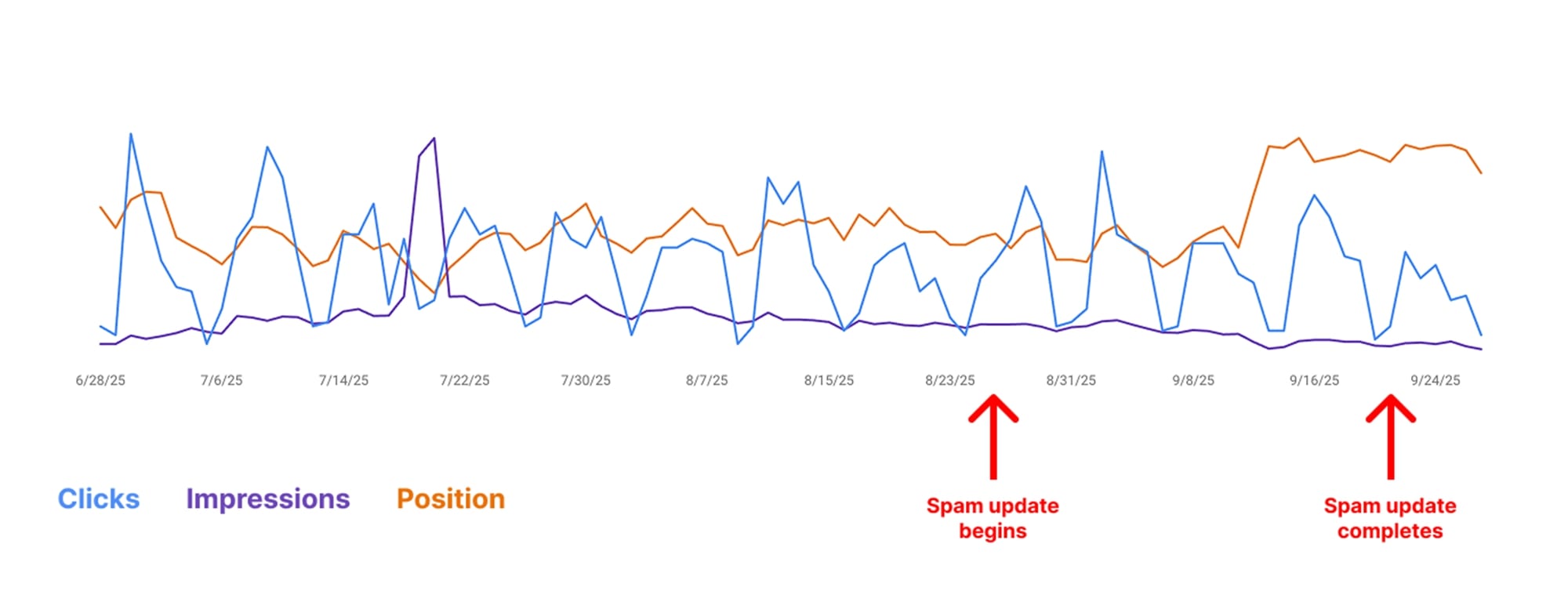
Google just delivered a message to everyone on the internet: they’ve had enough of (all the other) bots and slop.
Yes, the days of Search-As-We-Know-It are coming to a close. Google’s latest spam update draws a line in the proverbial sand as it tries to prevent its share of search from dropping further to Large Language Models like ChatGPT.
An unofficial part one focused on the June 2025 core update that improved search speed and context. But then this spam update happened, and I had to drop this part two to cover more ground.
So let’s take a look at the latest — and equally important — spam update that’s been shaking up the content marketing world for over three weeks now.
Google’s Latest Spam Update: What Happened?
The latest spam update, which finished deploying on September 21, 2025, revealed two major takeaways.
The first takeaway is that Spambrain, its AI-based spam-prevention system, got a few enhancements. Some SEO professionals have noticed significant drops in traffic on some pages created primarily with AI, potentially as a result of “scaled content abuse”, or content produced en masse seemingly for the sole sake of ranking for search results.
The second is that Google just limited the number of listings that you see on the search results page to 10. Previously, the URL parameter &num=100 could be added to the link to retrieve 100 results on one page, instead of the default 10. This enabled SEO software platforms like Ahrefs and Semrush to expand their ability to track position beyond the first page of results.
This coincided almost exactly with a massive drop in impressions and a spike in search position for many sites, Mindgrub’s included.

This has led to a lot of folks in the SEO community “crashing out”, as the kids say. Knowing this data is very important to content marketers, publishers, and public relations professionals; it allows us to refine our strategies, uncover new topics of discussion, and understand our audience and competition. Not to mention that it’s a pivotal feature for most SEO software platforms.
How Does Google’s Spam Update Affect Content Marketers & Publishers?
Google Strong-Arms Its Way Into the Standard For SEO Data
Removing the ability to see 100 results at a time is actually a huge deal. It means that these companies need to increase their efforts by anywhere from 2–10 times more, but it also means that Google’s data might truly be more accurate with fewer third-party bots inflating impressions, thus satisfying a potential compliance requirement down the road.
All this to say that the latest antitrust rulings against Google may actually have given them more power over their proprietary data in the long run.
You can’t forget for a single second about the search giant’s antitrust battles. It would be apparent that the Google Search Console team sees its SEO progenitors as competition. Yet, its fixation may be on ensuring Search Console data is as precise as possible, precisely for that reason.
Wait, Are You Saying All Those Impressions Were Just Bots?!?!?!
Yeah! Probably! Google Search Advocate John Mueller alluded to such in a reply on Bluesky.
He later elaborated that bots may need to be verified moving forward.
And honestly, I don’t hate this move if it means a higher-fidelity look at our search data.
Low-Quality, Low-Effort AI “Slop” Content is a Losing Strategy
Google has made it very clear in its Spam policy that a scaled use of AI to create and publish content goes against its standards. We don’t know for sure how large that scale needs to be to violate the policy, but it does mention avoiding using “generative AI tools or other similar tools to generate many pages without adding value for users.”
While content marketing is undoubtedly integral to a marketing strategy, content marketing at scale is likely not going to work as well for your search engine rankings in 2026 as it has in years past.
… Just Not for Google
Some see this year’s updates as an “extinction-level event” for SEO and possibly pay-per-click (PPC). Given the practical entirety of Search’s revenue comes from ads, I find it hard to believe the assertion that Google would swallow its own poison pill.
However, I’m certain that if I can think of a future when Google integrates ads into its AI Overviews, then they already have, too. For now (and that potential future), that will come at publishers’ expense as AI Overviews and zero-click search behaviors allegedly reduce traffic and eat into ad revenue.
So, “AI for me and not for thee”, is it? What’s a blogger to do?
4 Tips to Respond to the 2025 Google Spam Update
1. Don’t Panic
Now’s not the time to make massive changes to your website or content. Doing so may further complicate or compromise your position or rankings. If you have your data hooked up to Google Search Console, monitor your results and expect to see sudden fluctuations in traffic from August 2025 through early October. If you don’t have GSC connected, we can help with that. We can help you interpret those results, too.
2. Rethink Your Metrics
There are a lot of factors to this — time on page, return rate, and any key conversions you have set up are still vastly important. But with more people drifting toward LLMs and zero-search click behaviors, SEO’s value is moving away ever so slightly from on-site indicators and more toward a brand visibility/credibility effort.
Position may be king for now, while clicks are just icing on the cake. Impressions are a vanity metric. What’s the value in that? Ensuring your competition isn’t reaping the benefits.
3. Re-Evaluate Your SEO Software
We’re only starting to see how SEO software companies are responding to the latest update. Ahrefs and SpyFu have already announced their own future plans to either scale back or maintain their crawling capabilities, respectively. They could also be required to authenticate their crawlers moving forward.
If that’s the case, then there’s a possible future where you may need to ensure that your SEO software choice is authenticated, or risk inaccurate data. If you’re in the market for SEO software, you may want to wait a month or two to see how this all pans out. Time will tell.
4. A Possible Return to “Human-First” Digital Content Marketing
The rush to compete for broad keywords in 2025 may be a bit misguided. As more searches use long-tail conventions and specific matches, the bloat of generic articles continues to pile up unnecessarily under established pages.
I’m extremely optimistic about this. I’m hoping this serves as a wake-up call to creators that pieces should follow E-E-A-T (experience, expertise, authoritativeness, and trustworthiness) practices and not just boil down to how many keywords we can fit onto a page, while the content sounds robotic and unoriginal.
I got into this business in the first place because I loved forming my own perspectives on where technology was going, sharing those ideas with the world, then getting as many eyes on it as possible. After all, that’s what made the internet great — and Google a household name.
With so many changes, some businesses/organizations may choose not to invest in SEO anymore. The line of logic is that if it’s more difficult to rank and more difficult to get clicks, then why bother?
But that might be a nearsighted mistake. If your business is very established (think Fortune 500 or at least a household name), perhaps you don’t need SEO. But that would also give opportunities to your competition to capture visibility where another has abdicated it. And for the rest of the 99%, the idea of relinquishing brand visibility sounds wonderful only to your competitors.
The bottom line is that ranking on Google just got a lot harder. But leaving it altogether risks your brand’s reputation. The answer isn’t to drop out; it’s to double down on your content marketing and SEO strategies .